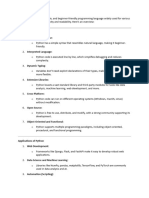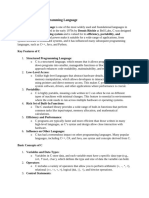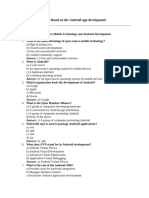Python Introduction
Uploaded by
rajsaini088Python Introduction
Uploaded by
rajsaini088Python is a powerful, high-level programming language known for its simplicity and readability.
Created by Guido van Rossum and released in 1991, Python was designed with the philosophy of
making code more intuitive and accessible, enabling both beginners and experienced developers
to solve problems efficiently. Python's syntax is often compared to English, making it easy to
learn, read, and write. This simplicity is combined with powerful libraries and frameworks,
making Python suitable for a wide range of applications, from web development to scientific
computing, data analysis, artificial intelligence (AI), and more.
Key Features of Python
1. Easy-to-Read Syntax: Python emphasizes readability, using indentation to denote code
blocks instead of braces, and minimizing punctuation. This allows programmers to
quickly write and understand code.
2. Interpreted Language: Python is an interpreted language, meaning that code is executed
line-by-line, making debugging easier and enabling interactive development.
3. Dynamic Typing: Python uses dynamic typing, which means variables don’t require
explicit declaration of data types. The type is inferred at runtime, allowing flexibility in
coding.
4. Object-Oriented Programming: Python supports object-oriented programming (OOP),
allowing developers to create reusable and modular code using classes and objects.
5. Extensive Libraries and Frameworks: Python’s vast ecosystem includes libraries for
various fields, such as NumPy and Pandas for data science, Django and Flask for web
development, and TensorFlow and PyTorch for machine learning. This robust support
makes Python a go-to language for many domains.
6. Cross-Platform Compatibility: Python runs on various operating systems, including
Windows, macOS, and Linux, with consistent behavior across platforms.
Python in Different Domains
1. Web Development: Frameworks like Django, Flask, and Pyramid enable Python to build
scalable web applications. Python’s simplicity allows quick development and iteration,
which is especially valuable in web development.
2. Data Science and Machine Learning: Python is the primary language for data science
and AI. Libraries like Pandas, NumPy, Matplotlib, and Scikit-Learn are integral for data
manipulation, visualization, and analysis, while TensorFlow and PyTorch are widely
used for machine learning.
3. Automation and Scripting: Python is widely used for automating repetitive tasks,
whether it’s in system administration or data processing. The simplicity and versatility of
Python make it a powerful tool for scripting and automation.
4. Game Development: Although less common, Python can be used for game development
with libraries like Pygame, offering an accessible way to create simple 2D games and
prototypes.
5. Desktop Applications: Python also supports creating cross-platform desktop applications
with libraries like Tkinter (built-in with Python) and PyQt.
Python’s Popularity and Community
Python’s popularity has grown exponentially in recent years, largely due to its ease of use,
versatility, and extensive community support. It is widely taught in educational institutions and
used by tech giants like Google, Facebook, and Instagram. Python's community has produced an
extensive collection of resources, tutorials, and documentation, making it accessible for both
beginners and experts to learn and contribute.
Hello World Example
A simple "Hello, World!" program in Python is as straightforward as:
python
Copy code
print("Hello, World!")
This code demonstrates Python's simplicity and readability.
Conclusion
Python’s simplicity, flexibility, and broad application areas have made it one of the most popular
programming languages in the world. Its capabilities in automation, data science, web
development, and more make Python an essential tool for both beginner programmers and
experienced developers.
You might also like
- AC Voltmeter With Digital Display - Project With Circuit Diagrams0% (1)AC Voltmeter With Digital Display - Project With Circuit Diagrams3 pages
- Docker and K8s Master Program - Syllabus - Mithun Technologies - 2022No ratings yetDocker and K8s Master Program - Syllabus - Mithun Technologies - 20224 pages
- Jabatan Teknologi Maklumat Dan Komunikasi Teknologi Sistem Komputer Dan RangkaianNo ratings yetJabatan Teknologi Maklumat Dan Komunikasi Teknologi Sistem Komputer Dan Rangkaian6 pages
- The forest was alive with the sound of rustling leaves and the occasional snap of a twig underfootNo ratings yetThe forest was alive with the sound of rustling leaves and the occasional snap of a twig underfoot3 pages
- Essential Guide To Python For All Levels (2024 CollectionNo ratings yetEssential Guide To Python For All Levels (2024 Collection184 pages
- Practical Guide to Python: From Basics to Advanced ProgrammingFrom EverandPractical Guide to Python: From Basics to Advanced ProgrammingNo ratings yet
- Python Programming Unit - I: History of PythonNo ratings yetPython Programming Unit - I: History of Python18 pages
- Python Django Internship Report 5 - PagenumberNo ratings yetPython Django Internship Report 5 - Pagenumber52 pages
- Technical Text- Programming Language PytthonNo ratings yetTechnical Text- Programming Language Pytthon3 pages
- CPSC 121: Models of Computation Lab #5: Flip-Flops and Frequency DivisionNo ratings yetCPSC 121: Models of Computation Lab #5: Flip-Flops and Frequency Division8 pages
- 20.2 User's Guide: Document Imaging SolutionsNo ratings yet20.2 User's Guide: Document Imaging Solutions93 pages
- The UNIX Shells (Bourne Shell, Korn Shell, C Shell)No ratings yetThe UNIX Shells (Bourne Shell, Korn Shell, C Shell)64 pages
- Sougata Jana - CSC407_OS_2nd_Year_CSE_SET3No ratings yetSougata Jana - CSC407_OS_2nd_Year_CSE_SET32 pages


































































































